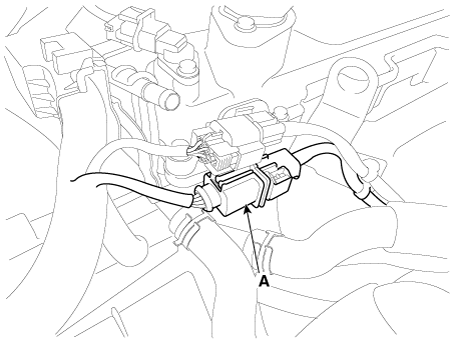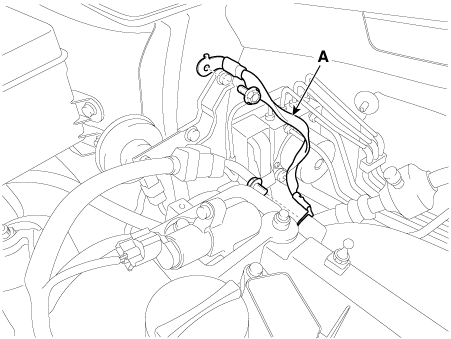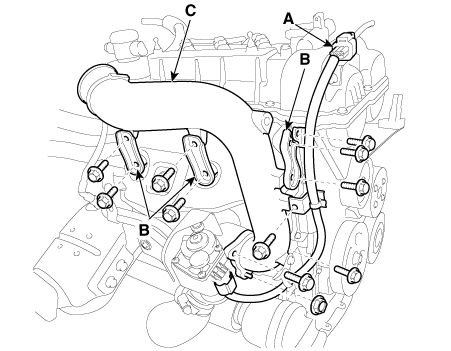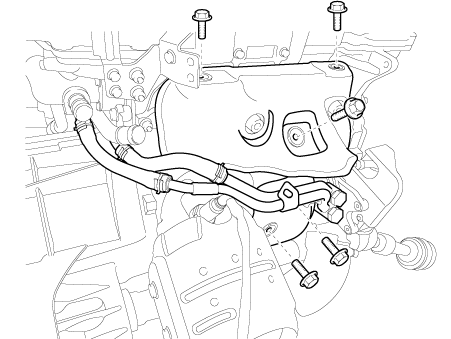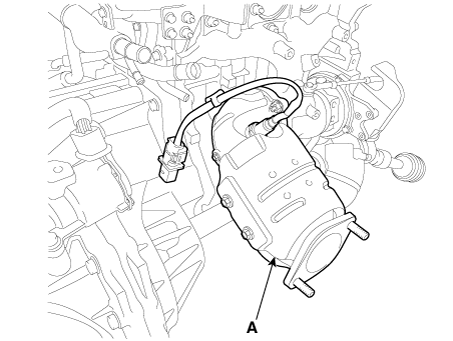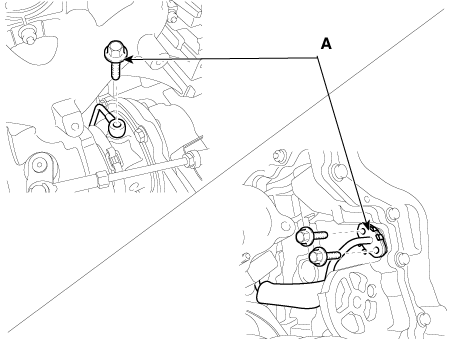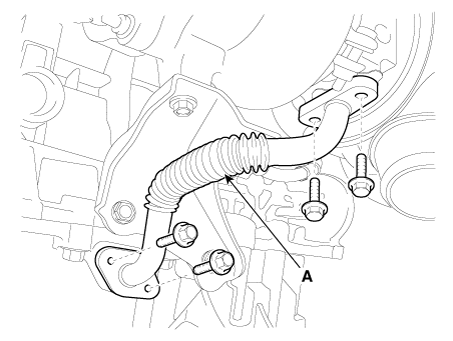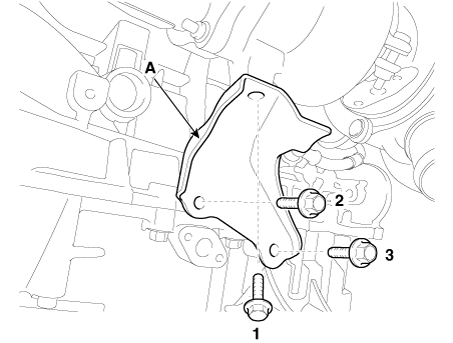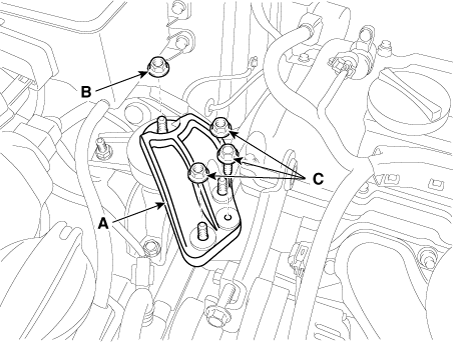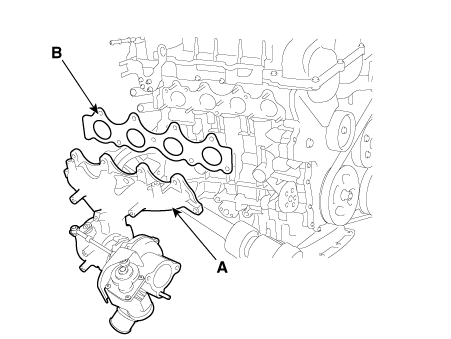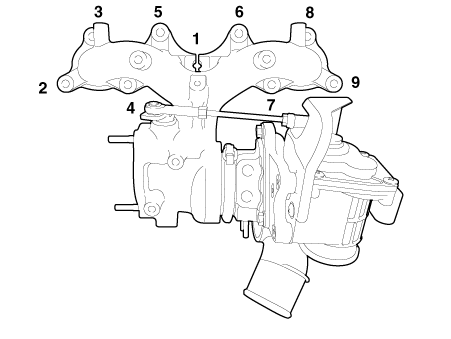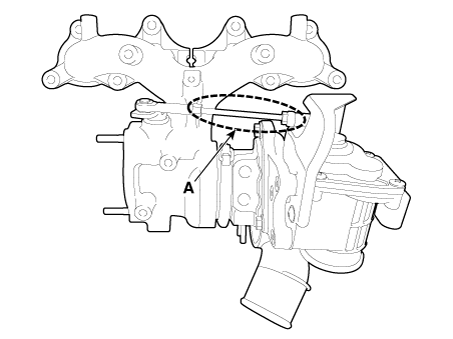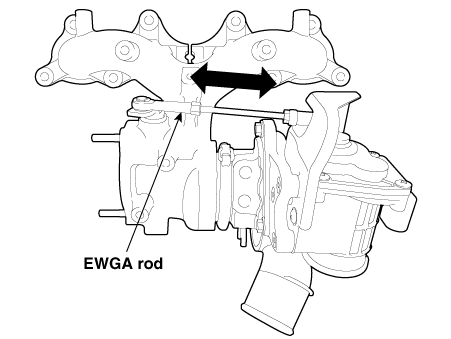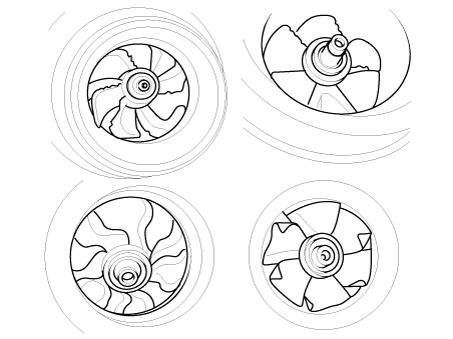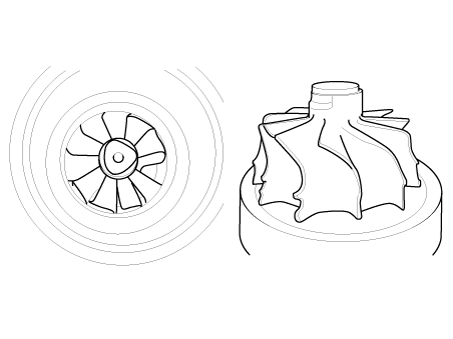Kia Forte: Intake And Exhaust System / Turbocharger & Exhaust Manifold
Components and components location
| Components |
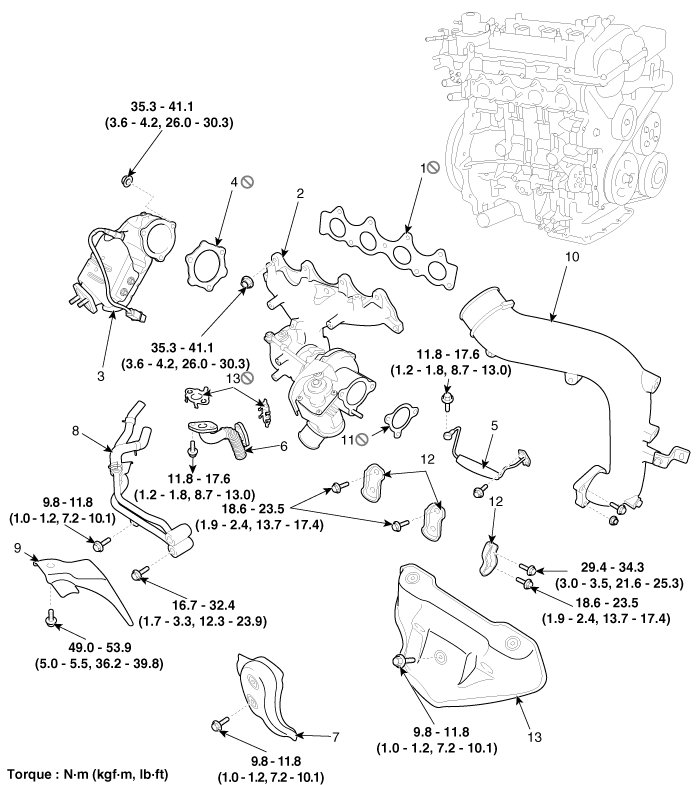
| 1. Turbo manifold gasket 2. Turbo manifold module 3. Catalytic converter 4. Turbo charger coupler & gasket 5. Oil feed pipe & hose assembly 6. Oil drain pipe assembly |
7. Turbo manifold module heat
protector 8. Turbo charger water pipe & hose assembly 9. Turbo charger stay 10. Intake pipe 11. Intake pipe gasket 12. Intake pipe stay 13.Oil drain pipe gasket |
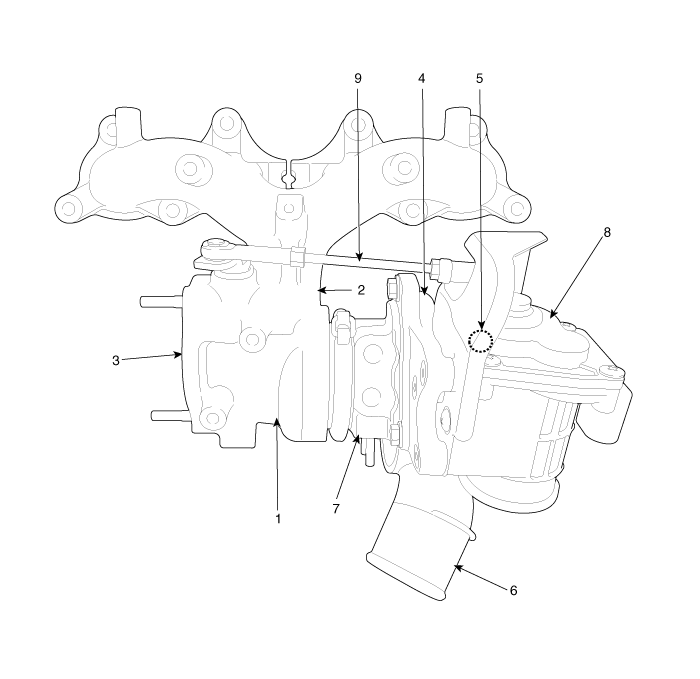
| 1. Turbine
housing 2. Turbine inlet 3. Turbine outlet 4. Compressor housing |
5. Compressor
inlet 6. Compressor outlet 7. Electric waste gate actuator 8. Electric waste gate actuator rod |
Repair procedures
| Removal and Installation |
| 1. |
Remove the engine cover. (Refer to Engine and Transmission Assembly - "Engine Cover") |
| 2. |
Remove the engine room under cover. (Refer to Engine and Transmission Assembly - "Engine Room Under Cover") |
| 3. |
Drain the engine coolant. (Refer to Cooling System - "Coolant") |
| 4. |
Remove the battery and battery tray. (Refer to Engine Electrical System - "Battery") |
| 5. |
Remove the air cleaner assembly. (Refer to Intake and Exhaust System - "Air Cleaner") |
| 6. |
Remove the front muffler. (Refer to Intake and Exhaust System - "Muffler") |
| 7. |
Disconnect the front oxygen sensor connector (A).
|
| 8. |
Disconnect the engine ground cable (A).
|
| 9. |
Disconnect the electric waste gate actuator (EWGA) extension connector (A). |
| 10. |
Remove the intake pipe stay (B).
|
| 11. |
Remove the intake pipe(C) and gasket.
|
| 12. |
Remove the turbo charger water pipe & hose (A).
|
| 13. |
Remove the turbo manifold module heat protector (B).
|
| 14. |
Remove the catalytic converter (A).
|
| 15. |
Remove the turbo charger oil feed pipe (A).
|
| 16. |
Remove the turbo charger oil drain pipe (A).
|
| 17. |
Remove the turbo charger stay (A).
|
| 18. |
Remove the engine mounting support bracket.
|
| 19. |
Remove the turbo manifold module (A) and gasket (B).
|
| 20. |
Install in the reverse order of removal.
|
| On-vehicle Inspection |
| Turbocharger Diagnostic Flow |
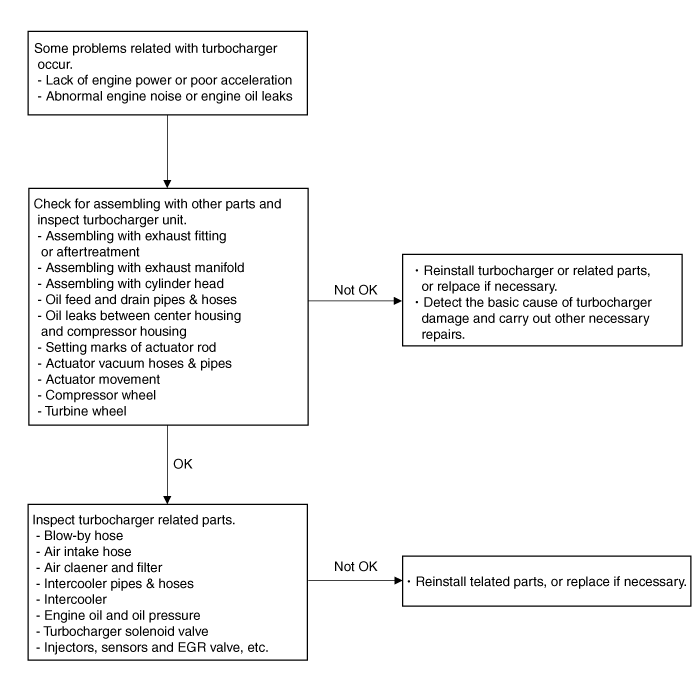
If any problem related with turbocharger, such as lack of engine power, poor acceleration, abnormal engine noise or oil leaks, may occur, check the turbocharger according to the procedure as follows.
| 1. |
Check for assembling of the turbocharger and the exhaust fitting (or the after treatment).
If a gas leak occur as a gasket was not installed or mounting bolts (or nuts) were tightened inadequately, it may cause abnormal engine noise. If the cause of the problem is detected, retighten the mounting bolts (or nuts) as the specified torque or replace the gasket or damaged parts with new ones if necessary. |
| 2. |
Check for assembling of the turbocharger and the exhaust manifold.
If a gas leak occur as a gasket was not installed or mounting bolts (or nuts) were tightened inadequately, it may cause abnormal engine noise. If the cause of the problem is detected, retighten the mounting bolts (or nuts) as the specified torque or replace the gasket or damaged parts with new ones if necessary. |
| 3. |
Check for assembling of the exhaust manifold and the cylinder head.
If a gas leak occur as a gasket was not installed or mounting bolts (or nuts) were tightened inadequately, it may cause abnormal engine noise. If the cause of the problem is detected, retighten the mounting bolts (or nuts) as the specified torque or install a new gasket if necessary. |
| 4. |
Check the turbocharger oil feed pipe & hose and oil drain pipe & hose.
If a gas leak occur as a gasket was not installed or mounting bolts were tightened inadequately, it may cause oil leaks. If the oil feed pipe & hose is damaged, engine oil is not supplied sufficiently to the turbocharger then it may damage the turbocharger. If the oil drain pipe & hose is damaged and clogged, engine oil is not drained smoothly then it may cause oil leaks from the turbocharger. If the cause of the problem is detected, retighten the mounting bolts (or nuts) as the specified torque or replace the gasket or damaged parts with new ones if necessary. |
| 5. |
Check for oil leaks between center housing and compressor housing.
If the O-ring (gasket) between the center housing and the compressor housing is damaged, it may cause oil leaks. If an oil leak is detected, replace the turbocharger with a new one. |
| 6. |
Check the setting marks of the turbocharger EWGA rod.
If the setting marks are not aligned in line, the engine performance is changed by an arbitrary tune-up of the turbocharger after delivery. If the setting marks are not aligned in line, replace the turbocharger with a new one. |
| 7. |
Check the turbocharger EWGA.
If the turbocharger EWGA is damaged, it may cause lack of engine power and poor acceleration. If the EWGA rod does not move, replace the turbocharger with a new one. |
| 8. |
Check the turbocharger compressor wheel.
If the compressor wheel are damaged, it may cause abnormal noise from the turbocharger and poor acceleration. If the compressor wheel are damaged or deformed, replace the turbocharger with new ones. |
| 9. |
Check the turbocharger turbine wheel.
If the turbine wheel are damaged, it may cause abnormal noise from the turbocharger and poor acceleration. If the turbine wheel are damaged or deformed, replace the turbocharger with new ones. |
If any problem is not detected in the turbocharger, check the turbocharger-related parts according to the procedure as follows.
| 1. |
Check the blow-by hose.
If the breather hose is bent or clogged, the internal pressure in the engine increases then engine oil is not supplied smoothly to the turbocharger. So it may cause damage of the turbocharger and oil leaks. If the cause of the problem is detected, replace the breather hose or the related parts with new ones. |
| 2. |
Check the air intake hose connected to the turbocharger.
If a cross-section of the hose diminishes as the air intake hose is bent or crushed, intake air to the turbocharger reduces and the pressure in front of turbocharger drops. So it may cause damage of the turbocharger and oil leaks. If the air intake hose is detached or torn, a foreign substance goes into the turbocharger and causes damage of it. If the air intake hose is damaged, replace it with a new one. |
| 3. |
Check the air cleaner.
If the air cleaner filter is moistened or polluted excessively or a non-genuine part is used, intake air to the turbocharger reduces and the pressure in front of turbocharger drops. So it may cause damage of the turbocharger and oil leaks. . If the air cleaner filter is moistened or polluted excessively, replace it with a new one.
|
| 4. |
Check the intercooler hoses & pipes.
If the intercooler hoses & pipes are damaged or disconnected, oil leaks may occur from the hoses & pipes and the turbocharger may exceed the permissible speed then it may cause damage of the turbocharger. If the intercooler hoses & pipes are damaged, replace them with new ones.
|
| 5. |
Check the intercooler.
If the intercooler is damaged, the turbocharger may exceed the permissible speed then it may cause damage of the turbocharger. If the intercooler is damaged, replace them with a new one.
|
| 6. |
Check the engine oil.
If the engine oil level is low, amount of engine oil fed to turbocharger reduces then the bearings in the turbocharger may adhere due to insufficient lubrication and cooling. If the cause of the problem is detected, add or change engine oil.
|
| 7. |
Check the engine oil pressure.
If the engine oil level is low, amount of engine oil fed to turbocharger reduces then the bearings in the turbocharger may adhere due to insufficient lubrication and cooling. If the cause of the problem is detected, add or change engine oil. If foreign substances are accumulated on the oil screen, wash the oil screen and replace the injector’s washer with a new one after checking the injectors for gas leaks. Check the engine oil-related parts, such as oil pump, if necessary.
|
| 8. |
Check the injectors, sensors, EGR valve, etc. (Refer to FL group)
If the injectors, sensors, EGR valve and etc. don’t work properly, it may cause lack of engine power. If the cause of the problem is detected, replace the related parts with new ones. |
 Intake Manifold
Intake Manifold
Components and components location
Components
1. Intake manifold assembly
2. Intake manifold gasket
3. Electronic throttle body gasket
4. Electronic th ...
 Intercooler
Intercooler
Components and components location
Components
1. Intercooler
2. Intercooler inlet hose
3. Intercooler inlet hose & pipe
4.Intercooler
hose &am ...
Other information:
Kia Forte 2019-2025 (BD) Owners Manual: Manual heating and air conditioning
The heating and cooling system can be controlled manually by pressing buttons or turning knob(s) other than the AUTO button. In this case, the system works sequentially according to the order of buttons or knob(s) selected. 1. Start the engine. 2. Set the mode to the desired position. ...
Kia Forte 2019-2025 (BD) Service Manual: Front Door
Components and components location Components 1. Front door trim 2. Front door panel 3. Front door side impact pad 4. Front door hinge 5. Front door quadrant inner cover 6. Front door belt inside weatherstrip 7. Front door belt outside weathers ...

